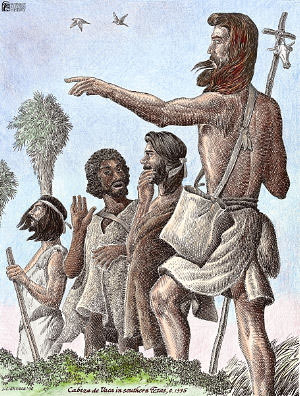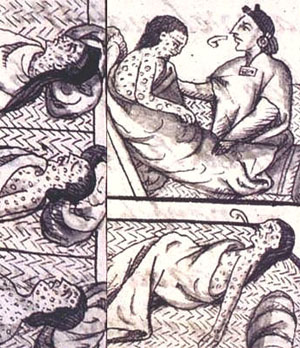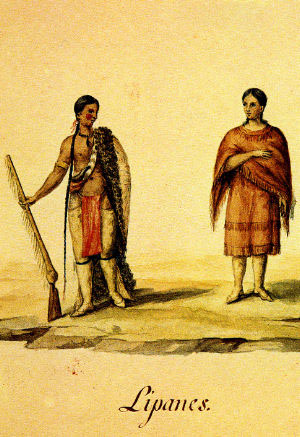|
Of all the state's regions, the South Texas Plains stands out as one of the most colorful and richly documented during early Historic times. Spanish explorers, officials, missionaries, soldiers, and others traveled across the grassy plains and brush country in the early 1500s and 1600s. Their journals and reports give us tantalizing glimpses of the region’s native peoples. These accounts, though inconsistent and often frustratingly brief, are peppered with mentions of sparsely clothed people, odd-sounding languages, primitive shelters, wild foods, and curious cooking techniques. Some writings, such as those of the explorer Cabeza de Vaca—who actually lived and worked among south Texas native groups —provide rare insights into the traditions, worldview, and thinking of some of the native peoples.
The earliest Europeans in south Texas encountered peoples whose basic way of life seems to have changed very little over the centuries, what anthropologist W. W. Newcomb termed "fossil cultures." Said differently, when the first Spanish arrived, the native peoples of the South Texas Plains followed a very long cultural tradition, a quintessential example of what anthropologists call a successful adaptation to a challenging setting. Because of this, these early historic encounters are of prime significance to archeologists and others hoping to understand and interpret prehistoric lifeways. They are, in effect, our most direct connection from the relatively recent to the distant prehistoric past, providing eye-witness accounts of some of the behaviors we see represented in artifacts and archeological sites.
By the time of their witness, however, cultural upheavals among these aboriginal groups had already begun, although the effects may not have been recognized by the Spanish observers. As early as the 16th century, perhaps even before Cabeza de Vaca's shipwreck, the impact of the Spanish in other areas of New Spain was being felt indirectly by native groups in Texas. European diseases spread rapidly across the continent, unwittingly passed from group to group through trade and other interactions.
The appearance of totally foreign Old World peoples in the New World set off so many far-reaching changes, through disease, new technologies, new animals and plants, new forms of transportation, new religions, and new economic patterns. Group after group, their numbers ever thinner, retreated, joined together with one another, fought losing battles with intruders, and tried to adapt to the new world order. Within a few centuries most native societies were gone forever.
When first encountered, all of the native peoples of the South Texas Plains were hunters and gatherers, just like most societies in adjacent regions of Texas. Hunter-gatherer life is highly mobile and requires people to move seasonally and even daily from place to place in search of food and other resources. For the first few centuries after contact these traditional lifeways continued, even in the face of increasing influences by the Europeans. Some groups took on new trappings acquired from the intruders—horses improved their ability to move from place to place, metal and glass were adapted to make traditional tools and weapons. Over time, however, the foreign influences were devastating to the native cultures, as the European intruders sought, alternately, to enslave, convert, congregate, or eliminate them.
In spite of the relatively fuller accounting we have of some of these indigenous peoples, our overall knowledge of the Indians of the South Texas Plains remains a complex puzzle with most of its pieces missing. There were hundreds of native bands living in the region at the time of contact, hundreds of different names for them, and only fleeting, spotty accounts of some of their territorial locales. Our modern understandings of the native peoples of the South Texas Plains are complicated by the fact that a single overarching, or collective, name has been applied to them all: Coahuiltecans.
The name comes from Coahuila, that part of the northeastern frontier of New Spain which once included most or all of the area occupied by the modern state of Texas on one side of the Rio Grande, as well as portions of the Mexican states of Coahuila, Nuevo Leon, and Tamaulipas on the other. As applied to native peoples, the term Coahuiltecan comes from Coahuilteco, coined by a 19th-century Mexican linguist for one of the major native languages spoke in the area. But other unrelated languages were also spoken in south Texas and northeastern Mexico and it is clear that the peoples of the region represented many different ethnic groups, tribes, and nations.
The term Coahuiltecan has become entrenched in history books and other literature. Unfortunately, it is interpreted by nonspecialists as implying that the native peoples of south Texas and northeastern Mexico (Coahuila) were, in essence, one large, genetically and/or ethnically related culture, who spoke the Coahuilteco language.
Researchers today see the cultural milieu on the South Texas Plains in Late Prehistoric/Early Historic times as far more complicated. We now understand that many of the native groups of the region, although practicing similar ways of life, were ethnically distinct, had different names for themselves, and spoke diverse languages, including Coahuilteco, Sanan, Comecrudo, Cotoname, and others. Today we realize the term Coahuiltecan is only valid in a geographic sense as a broad reference to the many native groups that once ranged across the Spanish province of Coahuila in northeastern Mexico and throughout the South Texas Plains.
Tracing South Texas Peoples
The earliest glimpse of the groups who occupied this region was given to us by Cabeza de Vaca and his three companions. Shipwrecked on the Texas Gulf Coast in 1528, these men walked from the shores near present-day Galveston to Mexico City in a journey of between 2,300 and 2,640 miles that, after they finally left south Texas in 1534, took them 14 months. Their reports of that amazing journey, written in Mexico and Spain after their return, provide fascinating information on the many native peoples they encountered, including native groups of the South Texas Plains.
After 1536, Spanish authorities in Mexico were occupied with events unfolding elsewhere in New Spain. There were encounters and battles with native groups such as the Cacaxtle in the mid-1600s, but most of the South Texas Plains remained a native domain. The pace of change and encounter picked up in the late 1600s when the Spanish learned that La Salle, a French entrepreneur, had established a French colony on the Texas Gulf Coast. Spanish military and missionaries returned to south Texas in relative abundance. They crossed the South Texas Plains on their travels to and from Matagorda Bay and to and from the Caddoan areas of east Texas. During those expeditions, the Spanish identified hundreds of names for groups occupying the region. Researchers believe that some of these groups were native to the region, while others moved in during the centuries after the Spanish were well established in Texas.
A list of groups thought to have spoken Coahuilteco and Sanan is shown here to illustrate another complexity in studying the native record. Based on the sheer numbers of native group names alone, it would appear the region was heavily populated. According to inventories and other records of the time, however, that appears not to have been the case. Although accounts vary, most of the groups were relatively small in number. For example, one group, the Pacuache, found by the Spanish along the middle Nueces River drainage, was estimated to have a population of about 350. Information for others, where it exists, suggests that individual groups maintained a population between 100 and 300.
Looking at the region from a human ecology perspective, Texas A&M archeologist Alston Thoms believes that the south Texas native population, though relatively small, was the maximum that the environment could support at the time. The region was “packed.” Further, the presence of enemies made for even greater competition and need for ingenuity in subsistence strategies.
By the mid 1700s, other native groups had began moving into the region, either pushing local groups south into Mexico or assimilating them into their own societies. These intruding native groups included the Tonkawa and Mescalero and Lipan Apache, tribes which themselves had been displaced from home territories far to the north and northwest. The availability of horses transformed many Plains groups into mounted raiders the likes of which the New World had never known. Chief among them were the war-like Comanche who forced the Apache and others, in turn, to flee and push southward, form alliances, and adopt the mounted-raider lifestyle themselves or risk annihilation.
The small, indigenous south Texas cultures were crushed by the unrelenting forces all around them. Disease, intertribal conflict, and diminished access to resources left weak, displaced bands.Some willingly turned to the Spanish for protection; others were coaxed or forced into mission settings, although their confinement was usually temporary and “conversion” incomplete. Others were captured and taken into Mexico to provide labor for mining enterprises. All the while, disease continued to take its toll on the vulnerable native populations. By the 19th century before the Republic of Texas was birthed, the true native peoples of the South Texas Plains were reduced to remnant survivors who were soon absorbed into Mexican society. Even today, however, there are surviving genetic traces and there are individuals and "resurgent" groups who identify with the Native American heritage of the region.
In This Exhibit
In the following sections, we look at the native peoples of South Texas and those who have helped uncover their stories. How Do We know About Native Lifeways? introduces readers to the researchers who have pored over Spanish documents to tease out descriptions and bits of information. Who Were the "Coahuiltecans"? provides a look at some of the many naciones who have been grouped under this name and what we know about their traditions and ways of life. Native Intruders from the North provides a brief overview of latecomers to the region who in some cases, effectively delivered a death thrust to many of the native groups of the South Texas Plains or forced them into the Spanish missions for survival. Credits and Sources provides useful resources for learning more about the region and its peoples.
|
| During the early Historic Period, native peoples of the region still practiced
traditional hunting and gathering lifeways in spite of increasing impacts by
Anglo-Europeans. Eyewitness accounts of these “fossil cultures” serve as a connection to the distant
prehistoric past and the activities we see represented in artifacts and archeological sites. |

Shipwrecked off the coast of Texas in 1528, Spanish explorer Cabeza de Vaca and
his companions traveled across south Texas and northeastern Mexico, living among native groups for
several years. The accounts of this journey provide some of our richest insights into native life
ways. Painting from “Borderlands: The Heritage of the Rio Grande through the Art of Jose Cisneros,”
courtesy of the Museum of South Texas History, Edinburg, Texas.  |
 = image can be enlarged. = image can be enlarged. |

Introduced by Europeans, diseases, including smallpox, measles, and cholera, decimated native groups in Texas as in other parts of the country.  |
Coahuilteco Speakers:
Aguapalam
Aguastaya
Anxau
Apaysi
Archjomo
Ataxal
Cachopostal
Cauya
Chayopin
Geyer
Juanca
Manico
Mescal
Ocana
Paac
Paachiqui
Pacao
Pachal
Pachaque
Pacoa
Pacpul
Pacuache
Pajalat
Pamaya
Pampopa
Papanac
Pastaloca
Pastia
Patacal
Pataguo
|
Patumaco
Patzau
Pausane
Payaya
Payuguan
Pitahay
Pitalac
Pulacuam
Quem
Sacuache
Samampac
Sampanal
Sanaque
Saracuam
Semonan
Siaguam
Siquipil
Sonayan
Sulujam
Tacame
Tilijae
Tilpacopal
Tepacuache
Yorica
|
|
Sanan Speakers:
Aujuiap
Caguas
Cocmeioje
Emate
Macocoma
Menanquen
Mesquites
|
Paguanan
Sana
Sijame
Tacam
Tenu (Tina)
Tojo
Zorquan |
|

Lipan Apaches were among the “intrusive” Plains groups entering south Texas in
the early Historic Period. Indigenous peoples were alternately pushed into Mexico by the frequently
hostile invaders or, in some cases, assimilated into the tribe. Artist’s depiction drawn during the
1828 Berlandier expedition through Mexico and south Texas.  |
|